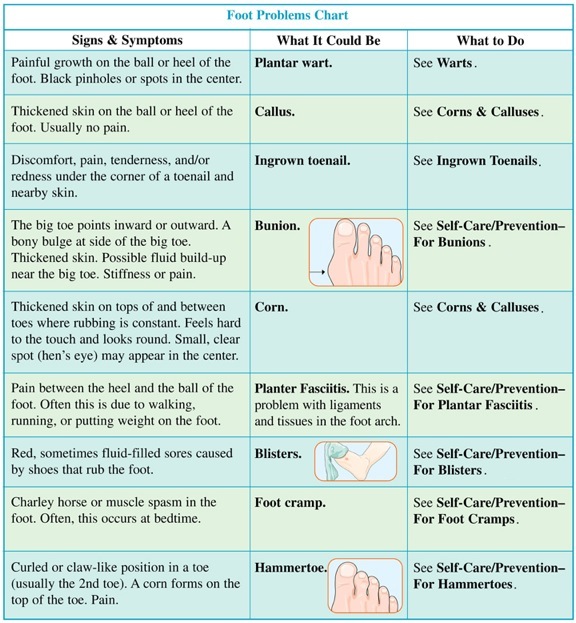-
Muscle & Bone Problems





Foot Problems
Some foot problems are due to years of wear and tear on your feet. Others can be due to shoes that do
not fit well or trimming your toenails too close to your skin. Circulation problems and diseases, such as diabetes, can lead to foot problems, too.
Self-Care / Prevention
For Blisters
-
•Don’t break a blister. If it breaks on its own, apply an antibacterial spray or ointment and cover with a bandage or sterile dressing.
-
•Don’t cut away or pull off the broken blister’s loose skin. This protects the new skin below it.
For Bunions
-
•Don’t wear high heels or shoes with narrow toes.
-
•Wear sandals.
-
•Use moleskin or padding to separate overlapped toes.
-
•Try arch supports to reduce pressure.
-
•Use ring-shaped pads over a bunion.
-
•Cut out an old pair of shoes to wear in the house.
-
•Soak your feet in warm water.
If you have diabetes or circulation problems, contact your doctor for any foot problem.

-
•If needed, take an over-the-counter pain reliever as directed.
For Foot Cramps
-
•Stretch the foot muscles.
-
•Pull the foot back into a flexed position.
-
•Push the foot into the floor.
For Heel Spurs
-
•Use a cushion or heel cup under the heel.
-
•Do not jog or run. Avoid prolonged standing.
-
•Lose weight, if overweight.
-
•Roll a tennis ball under ball of the foot.
-
•Put ice on the heel for 10 minutes. Remove it for 10 minutes. Repeat many times.
-
•If needed, take an over-the-counter pain reliever as directed.
For Hammertoes
-
•Wear wide, roomy shoes.
-
•Massage the toes or get a foot rub.
-
•Change shoes during the day. Try athletic shoes.
-
•Use small pads over the center of the toe to lessen pressure.
For Injuries
Use R.I.C.E.
-
•For an injured toe, tape it to the toe next to it. Do this for 7 to 10 days.
-
•Take an over-the-counter medicine to reduce swelling and pain as directed.
For Minor Infections
-
•Soak the foot in warm, soapy water for 20 minutes, 4 to 6 times a day. Pat the infected area dry. Use extra care if you have peripheral vascular disease. Make sure the water is not hot.
-
•Apply an over-the-counter antibiotic ointment, such as Neosporin. Cover with a sterile cloth or bandage.
For Morton’s Neuroma
-
•Wear wide shoes with soft insoles.
-
•Put pads or arch supports in your shoes. These help take pressure off the area.
-
•Take an over-the-counter medicine for pain as directed.
-
•See your doctor if the above measures don’t bring relief.
For Plantar Fasciitis
-
•Rest the foot as much as you can.
-
•Use R.I.C.E.
-
•Take an over-the-counter medicine for pain and swelling as directed.
-
•Wear shoes with a solid arch support.
For Plantar Warts
-
•Try salicylic acid plasters or other over-the-counter products, such as Wart-Off. Follow package directions.
-
•Use cushions in shoes.
-
•Wash your hands after touching warts to avoid re-infection.
-
•Wear sandals in the shower or public areas, such as pools.
-
•Do not pick at plantar warts.
To Help Prevent Foot Problems
-
•Wear shoes that fit well. Don’t wear shoes with pointed toes or ones that fit too tightly.
-
•Wash and dry your feet daily.
-
•Keep your feet moisturized.
-
•Inspect your feet daily for early signs of problems.
-
•Rest your feet by elevating them.
-
•Persons with diabetes and/or circulation problems need to take special care of their feet. Good foot care can prevent some foot infections. It may be necessary for a health care professional to cut the toenails.
{Note: If self-care measures do not help or if your foot problem gets worse, contact your doctor.}
See also, Self-Care / Prevention for:





Copyright © 2009, American Institute for Preventive Medicine. All rights reserved.